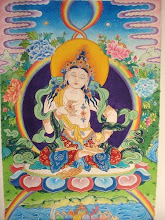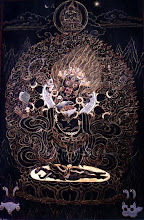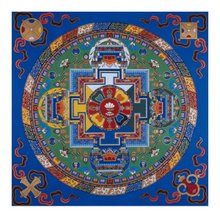Another western student of Tibetan Buddhism wanders into Nepal and is overwhelmed by the majesty of the mountains and intoxicated by the perfume of incense, chanting, temples, paintings and statuary. Canadian anthropologist Wade Davis quite clearly believes in the power of Buddhist practice to liberate the mind from illusion and suffering. He speaks about it passionately and eloquently and includes in his presentation more than one scene of himself succumbing to tears during teachings and meditation. But he seems to forget his purpose, to help a western audience understand that this practice has some basis in science. This chapter is, after all, entitled “Science of the Mind,” one of four chapters in “Light at The Edge of The World,” a National Geographic series exploring endangered indigenous cultures.
Wade interviews a nun who has been in solitary retreat for some 40 years, a mountain hermit who sits daily meditation and chants a single mantra, Om Mani Padme Hum. No doubt this is quite an impressive feat, sitting up there alone for four decades, but in presenting her practice as something benefiting all sentient beings, the question that comes to mind is - how is sitting on a mountain chanting more helpful than getting down into society and getting your hands dirty dealing with the day-to-day needs of the poor of Nepal? In what measurable way does her practice help anyone but herself?
Wade claims that the enlightened nature of people such as this nun or his teacher, Venerable Trulshik Rinpoche, is the empirical evidence attesting to the efficacy of the Buddhist practice. But what does it mean to be enlightened? What are the necessary conditions? How do we measure it? What is it that allows us to say this person is and this person isn't? We know that people from other cultures, some practicing other traditions, some practicing none, exhibit this kind of enlightened personality. Wade himself notes the proverbial 84,000 paths available to Buddhists, but doesn't question whether some are more effective than others in producing these enlightened states of mind. Perhaps it not Buddhism at all, but simply being on a spiritual path, opening oneself to new ways of seeing and experiencing.
But assuming that Tibetan Buddhism is one of many roads leading to a state of enlightenment, we never learn how one gets there, what specific practices are included in “the practice.” We can see in the film that chanting, praying, and meditation are involved, but no course is explicated. There's one scene where Davis shows French translator, author, and practitioner Matthieu Ricard wired for a laboratory experiment on mediation. We're told the results showed altered brain states, but beyond that it's up to us to imagine what might have been revealed. That's about as close as Davis gets to presenting the science of the mind.
“Science of the Mind" can currently be viewed in its entirety at YouTube.
#



























I might be remembering this wrong, but didn't Wade Davis also write 'The Serpent and the Rainbow' back in the 80s?
ReplyDeleteThe same, it appears. Were you unfortunate enough to have seen the movie?
ReplyDeleteUgh, yup. Very badly done.
ReplyDelete